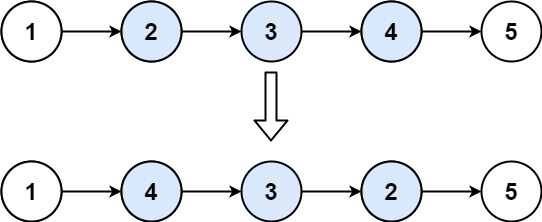算法leetcode|92. 反转链表 II(rust重拳出击)
文章目录
- 92. 反转链表 II:
- 样例 1:
- 样例 2:
- 提示:
- 进阶:
- 分析:
- 题解:
- rust:
- go:
- c++:
- python:
- java:
92. 反转链表 II:
给你单链表的头指针 head 和两个整数 left 和 right ,其中 left <= right 。请你反转从位置 left 到位置 right 的链表节点,返回 反转后的链表 。
样例 1:

输入:head = [1,2,3,4,5], left = 2, right = 4输出:[1,4,3,2,5]
样例 2:
输入:head = [5], left = 1, right = 1输出:[5]
提示:
- 链表中节点数目为 n
- 1 <= n <= 500
- -500 <= Node.val <= 500
- 1 <= left <= right <= n
进阶:
- 你可以使用一趟扫描完成反转吗?
- 将链表分成3部分,即前面不需要反转的部分,中间需要反转的部分,后面不需要反转的部分。
- 单向链表只能从一个方向遍历,并且不能随机访问,所以我们只能按照顺序处理,这里就不能有什么好的技巧了。
- 先处理前面不需要反转的部分,直接遍历跳过即可,这里由于没法随机访问,所以只能按顺序遍历。
- 接下来处理中间需要反转的部分,想象一下入栈,遍历一个节点就放到头(中间需要遍历部分的头),依次遍历处理,就完成了反转。
- 最后处理后面不需要遍历的部分,其实这部分不需要做什么处理,所以不需要继续遍历,但是要当心将链表接起来。
- 这里不得不说由于rust的所有权问题,同一时间只能有一个可修改指针,可能是二当家水平太菜,处理链表有点啰嗦。
分析:
- 面对这道算法题目,二当家的再次陷入了沉思。
题解:
rust:
// Definition for singly-linked list.
// #[derive(PartialEq, Eq, Clone, Debug)]
// pub struct ListNode {
// pub val: i32,
// pub next: Option<Box<ListNode>>
// }
//
// impl ListNode {
// #[inline]
// fn new(val: i32) -> Self {
// ListNode {
// next: None,
// val
// }
// }
// }
impl Solution {pub fn reverse_between(head: Option<Box<ListNode>>, left: i32, right: i32) -> Option<Box<ListNode>> {// 来个哑节点方便处理头节点在反转范围内的情况let mut dummy = Option::Some(Box::new(ListNode::new(0)));dummy.as_mut().unwrap().next = head;// 前面不需要反转部分的尾let mut pre = dummy.as_mut().unwrap();// 跳过前面不需要翻转的部分for _ in 0..left - 1 {pre = pre.next.as_mut().unwrap();}// 中间需要反转的部分(同时打断前面不需要反转部分和中间需要反转部分的链接)let mut cur = pre.next.take();// 进行反转for _ in 0..right - left {let mut next = cur.as_mut().unwrap().next.take();cur.as_mut().unwrap().next = next.as_mut().unwrap().next.take();next.as_mut().unwrap().next = pre.next.take();pre.next = next;}// 重新接上while pre.next.is_some() {pre = pre.next.as_mut().unwrap();}pre.next = cur;return dummy.unwrap().next;}
}
go:
/*** Definition for singly-linked list.* type ListNode struct {* Val int* Next *ListNode* }*/
func reverseBetween(head *ListNode, left int, right int) *ListNode {// 来个哑节点方便处理头节点在反转范围内的情况dummy := &ListNode{Val: 0, Next: head}pre := dummyfor i := 0; i < left-1; i++ {pre = pre.Next}cur := pre.Nextfor i := 0; i < right-left; i++ {next := cur.Nextcur.Next = next.Nextnext.Next = pre.Nextpre.Next = next}return dummy.Next
}
c++:
/*** Definition for singly-linked list.* struct ListNode {* int val;* ListNode *next;* ListNode() : val(0), next(nullptr) {}* ListNode(int x) : val(x), next(nullptr) {}* ListNode(int x, ListNode *next) : val(x), next(next) {}* };*/
class Solution {
public:ListNode* reverseBetween(ListNode* head, int left, int right) {// 来个哑节点方便处理头节点在反转范围内的情况ListNode *dummy = new ListNode(0);dummy->next = head;ListNode *pre = dummy;for (int i = 0; i < left - 1; ++i) {pre = pre->next;}ListNode *cur = pre->next;ListNode *next;for (int i = 0; i < right - left; ++i) {next = cur->next;cur->next = next->next;next->next = pre->next;pre->next = next;}return dummy->next;}
};
python:
# Definition for singly-linked list.
# class ListNode:
# def __init__(self, val=0, next=None):
# self.val = val
# self.next = next
class Solution:def reverseBetween(self, head: Optional[ListNode], left: int, right: int) -> Optional[ListNode]:# 来个哑节点方便处理头节点在反转范围内的情况dummy = ListNode(0)dummy.next = headpre = dummyfor _ in range(left - 1):pre = pre.nextcur = pre.nextfor _ in range(right - left):next = cur.nextcur.next = next.nextnext.next = pre.nextpre.next = nextreturn dummy.nextjava:
/*** Definition for singly-linked list.* public class ListNode {* int val;* ListNode next;* ListNode() {}* ListNode(int val) { this.val = val; }* ListNode(int val, ListNode next) { this.val = val; this.next = next; }* }*/
class Solution {public ListNode reverseBetween(ListNode head, int left, int right) {// 来个哑节点方便处理头节点在反转范围内的情况ListNode dummy = new ListNode(0);dummy.next = head;ListNode pre = dummy;for (int i = 0; i < left - 1; i++) {pre = pre.next;}ListNode cur = pre.next;ListNode next;for (int i = 0; i < right - left; i++) {next = cur.next;cur.next = next.next;next.next = pre.next;pre.next = next;}return dummy.next;}
}
非常感谢你阅读本文~
欢迎【点赞】【收藏】【评论】三连走一波~
放弃不难,但坚持一定很酷~
希望我们大家都能每天进步一点点~
本文由 二当家的白帽子:https://le-yi.blog.csdn.net/ 博客原创~
